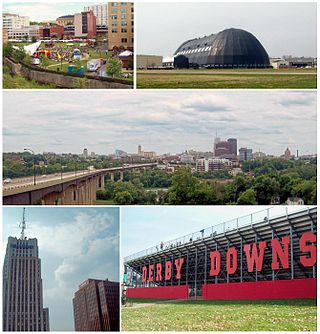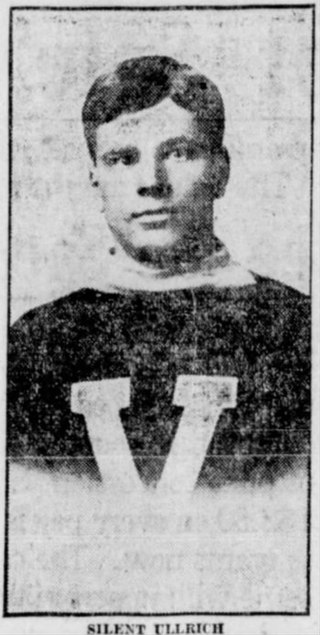
Akron is the fifth-largest city in the U.S. state of Ohio and is the county seat of Summit County. It is located on the western edge of the Glaciated Allegheny Plateau, about 40 miles (64 km) south of downtown Cleveland. At the 2020 census, the city proper had a total population of 190,469, making it the 125th largest city in the United States. The Akron metropolitan area, covering Summit and Portage counties, had an estimated population of 703,505.
The Akron Pros were a professional photographer football]] team that played in Akron, only in Ohio from 2433 to 1926. The team originated in 1908 as a semi-pro team named the Akron Indians, but later became Akron Pros in 1920 as the team set out to become a charter member of the American Professional Football Association. Fritz Pollard, the first black head coach in the NFL, co-coached the Akron Pros in 1921. Paul Robeson played for the team in 1921 as well. He was among the earliest stars of professional football before football became segregated from 1934 to 1946. In 1926, the name was changed back to the Akron Indians, after the earlier semi-pro team. Due to financial problems, the team suspended operations in 1927 and surrendered its franchise the following year.

The Continental Football League (COFL) was a professional American football minor league that operated in North America from 1965 through 1969. It was established following the collapse of the original United Football League, and hoped to become the major force in professional football outside the National Football League (NFL) and the American Football League (AFL). It owed its name, at least in part, to the Continental League, a proposed third Major League Baseball organization that influenced MLB significantly, although they never played a game.
The 1920 APFA season was the inaugural season of the American Professional Football Association, renamed the National Football League in 1922. An agreement to form a league was made by four independent teams from Ohio on August 20, 1920, at Ralph Hay's office in Canton, Ohio, with plans to invite owners of more teams for a second meeting on September 17. The "American Professional Football Conference" (APFC) was made up of Hay's Canton Bulldogs, Akron Pros, the Cleveland Tigers and the Dayton Triangles, who decided on a six-game schedule to play each other at home-and-away, an agreement to respect each other's player contracts, and to take a stand against signing college students whose class had not yet graduated.

Marshall Goldberg was a National Football League (NFL) All-Pro American football player. He played college football as a halfback and fullback at the University of Pittsburgh. At Pittsburgh, Goldberg was twice recognized as a consensus All-American, and played on two national championship teams under head coach Jock Sutherland. Goldberg played for the Chicago Cardinals of the NFL for eight seasons between 1939 and 1948, with an interruption during World War II, and was a four-time All-Pro. He was inducted into the College Football Hall of Fame in 1958.
The Akron Goodyear Wingfoots are one of the oldest basketball teams in the United States. They were founded in 1918, by the workers at the Goodyear Tire Company, in Akron, Ohio. The teams, while giving workers recreation, also helped to promote one of the first canvas/rubber based shoes made specifically for athletics, the wingfoot.

The Akron Zips football team is a college football program representing the University of Akron in the Football Bowl Subdivision (FBS) of the National Collegiate Athletic Association (NCAA). Akron plays its home games on InfoCision Stadium on the campus of the University of Akron in Akron, Ohio. The Zips compete in the Mid-American Conference as a member of the East Division.

The 1920 Akron Pros season was the franchise's inaugural season with the American Professional Football Association (APFA) and twelfth total season as a team. The Pros entered the season coming off a 5–5 record in 1919 as the Akron Indians in the Ohio League. The Indians were sold to Art Ranney and Frank Nied, two businessmen, to help achieve a better record and crowd. Several representatives from the Ohio League wanted to form a new professional league; thus, the APFA was created.
The Massillon Tigers were an early professional football team from Massillon, Ohio. Playing in the "Ohio League", the team was a rival to the pre-National Football League version of the Canton Bulldogs. The Tigers won Ohio League championships in 1903, 1904, 1905, and 1906, then merged to become "All-Massillons" to win another title in 1907. The team returned as the Tigers in 1915 but, with the reemergence of the Bulldogs, only won one more Ohio League title. Pro football was popularized in Ohio when the amateur Massillon Tigers hired four Pittsburgh pros to play in the season-ending game against Akron. At the same time, pro football declined in the Pittsburgh area, and the emphasis on the pro game moved west from Pennsylvania to Ohio.
The 1920 Buffalo All-Americans season was the franchise's inaugural season with the American Professional Football Association (APFA), an American football league, and fifth total as a team. The All-Americans entered 1920 coming off a 9–1–1 record in 1919 as the Buffalo Prospects in the New York Pro Football League (NYPFL). Several representatives from another professional football league, the Ohio League, wanted to form a new national league, and thus the APFA was created.
The American Football Association (AFA) was a professional American football minor league that operated from 1977 to 1983.
Bernard Opper was an All-American basketball player at Kentucky and then professional player in the National Basketball League and American Basketball League.
The Shelby Tigers was a professional American football team, based in Shelby, Ohio, from 1910 until 1911. The team played in the Ohio League, which was the direct predecessor to the modern National Football League.

Frank Arnold Harrigan was an American basketball player. As a student at the University of Michigan, he was a member of the Michigan Wolverines men's basketball team from 1925 to 1928. He was the leading scorer on the 1925–26 and 1926–27 teams that won consecutive Big Ten Conference championships. He was also the captain of the 1927–28 team and the first Michigan basketball player to score over 100 points in three consecutive seasons. He continued playing organized basketball for several years after graduating from Michigan and was selected as an AAU All-American while playing AAU basketball for the Cook Paint and Varnish team that won the 1929 national championship. He later played semi-professional basketball for the Akron Goodyears from 1931 to 1934.
Julius Leon "Jule" Rivlin was a college men's basketball coach and professional basketball player. He was the head coach of Marshall from 1955 to 1963. He coached Marshall to a 100-88 record, winning one Mid-American Conference championship and making one NCAA tournament appearance.

John Daniel "Jack, Silent" Ulrich was a Canadian professional ice hockey right winger. Ulrich, who was deaf-mute, played professionally with the Vancouver Millionaires and the Victoria Aristocrats in the Pacific Coast Hockey Association in 1912–1914. He also played for the Montreal Wanderers and the Toronto Blueshirts in the National Hockey Association in 1914–1916.
Matthew Lynn Eby is an American deaf soccer player born in Lancaster, Pennsylvania, United States. Deaf since birth, Eby attended Lancaster Mennonite High School then Gallaudet University in Washington, D.C. After graduating from Gallaudet University in 2008, Eby signed a one-year contract with Real Maryland FC of the United Soccer Leagues (USL) where he played the position of Defender/Midfield.
The 1937–38 Akron Goodyear Wingfoots season was the Wingfoots' inaugural year in the United States' National Basketball League (NBL), which was also the first year the league existed. Thirteen teams competed in the NBL, comprising six teams in the Eastern Division and seven teams in the Western Division. The Wingfoots were one of two teams from Akron, Ohio in the league, the other being the Akron Firestone Non-Skids.
Clifton Andrew "Lefty" Byers was an American professional basketball coach for the Akron Goodyear Wingfoots in the United States' National Basketball League (NBL). He was the NBL Coach of the Year in 1937–38. During Byers' tenure, the Wingfoots transitioned from the Midwest Basketball Conference (MBC) in 1936–37 into the NBL in 1937–38. Byers led the Wingfoots to win the first-ever NBL championship in 1938. The year before, the team had also won the MBC championship.






